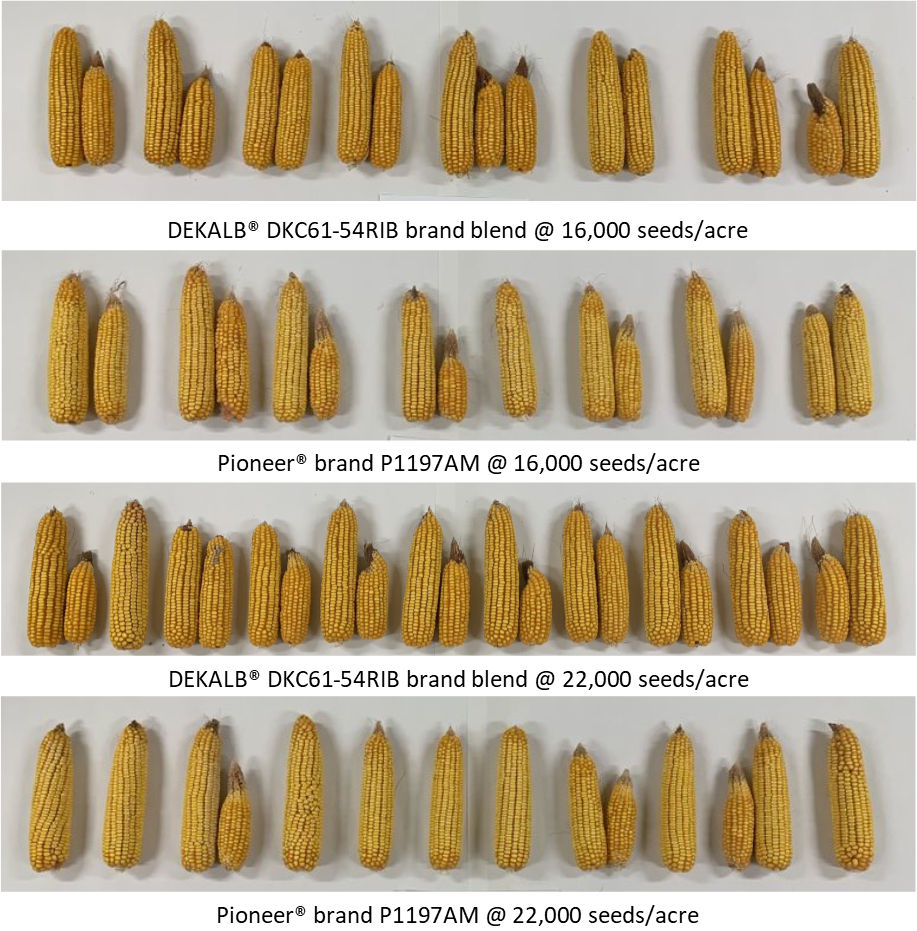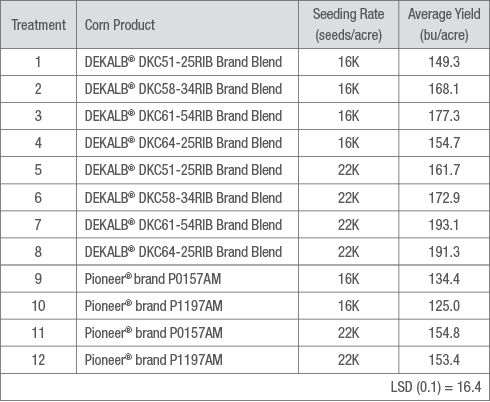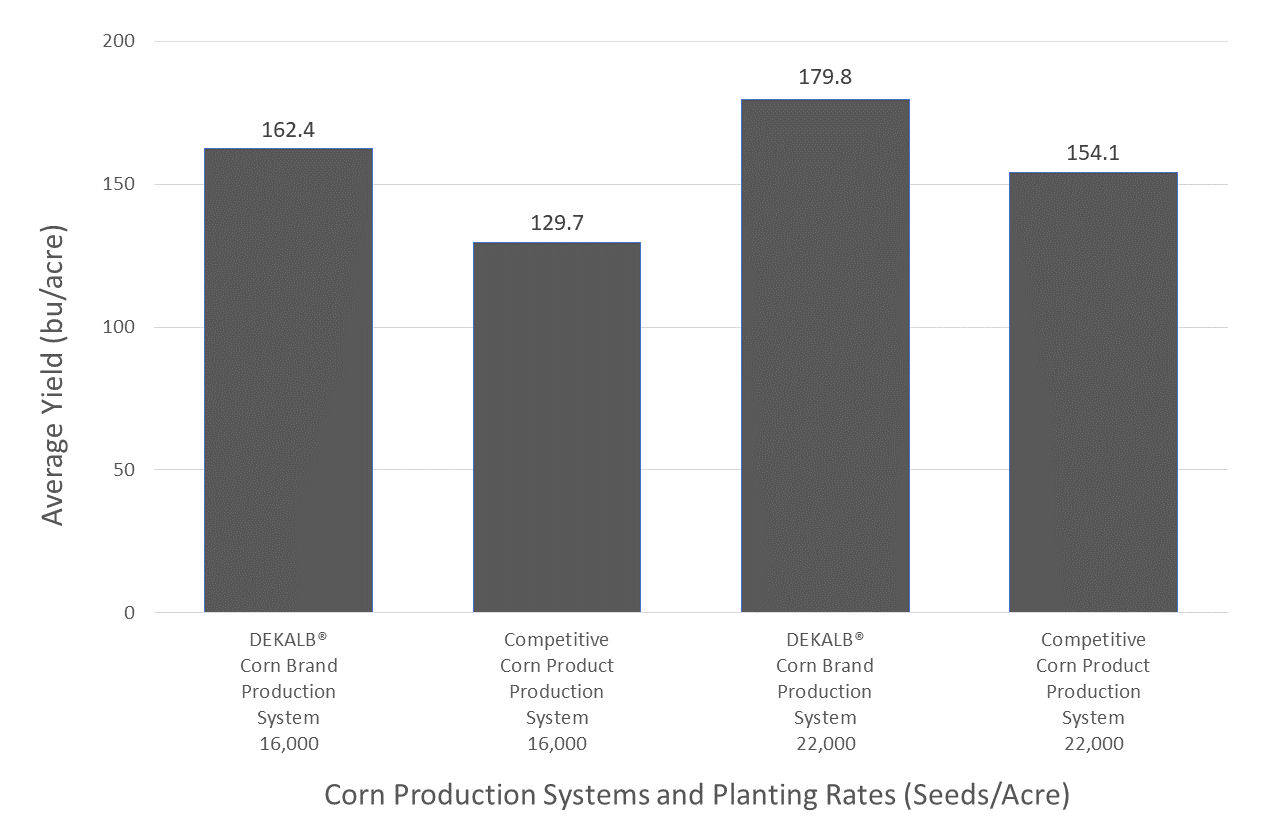Dryland Corn Production Systems in a Tough Environment
December 22, 2020
TRIAL OBJECTIVE
Successfully managing dryland corn requires a well-planned system to achieve the best results with limited moisture.
This research trial compares DEKALB® brand corn products and Bayer herbicide products to Pioneer® brand corn products and associated herbicide products in a dryland environment.
RESEARCH SITE DETAILS
Previous
Crop Sorghum Tillage
Type No tillage
Potential Yield
(bu/acre) 200 Seeding Rate
(seeds/acre)
16K, 22K
The study design was a randomized complete block with 12 treatments and four replications.
Four DEKALB® brand corn products and two Pioneer® brand corn products were planted at 16,000 and 22,000 seeds/acre, to simulate the lower and upper range of dryland seeding rates in the area. From Gothenburg, seeding rates trend lower as you move west and higher as you move east.
The previous crop was grain sorghum to provide a drier environment to stress the dryland corn systems.
Treatments 1 through 8 were planted to DEKALB® brand corn products and received a pre-emergence herbicide application of Balance® Flexx herbicide (0.125 qt/acre), Harness® Xtra 5.6L herbicide (2 qt/acre), Roundup PowerMAX® herbicide (1 qt/acre) and AMS (17 lb/100 gal), and a V6 application of DiFlexx® herbicide (0.25 qt/acre), AAtrex® 4L herbicide (0.5 qt/acre), Roundup PowerMAX herbicide (1 qt/acre) and AMS (17 lb/100 gal).
Treatments 9 through 12 were planted to Pioneer® brand corn products and received a pre-emergence herbicide application of Cinch® ATZ herbicide (2.25 qt/acre), Sterling Blue® herbicide (0.125 qt/acre), Durango® DMA® herbicide (1.1 qt/acre) and AMS (17 lb/100 gal), and a V6 application of Sterling Blue herbicide (0.25 qt/acre), AAtrex 4L herbicide (0.5 qt/acre), Durango DMA herbicide (1.1 qt/acre) and AMS (17 lb/100 gal).
The pre-emergence herbicide application occurred on 5/9/2020, and the V6 application occurred on 6/30/2020.
Fertility applied with a Chafer fertilizer stream bar included 20 lb nitrogen/acre, 50 lb phosphorus/acre, 11 lb sulfur/acre on 4/14/2020 and 150 lb nitrogen/acre applied 4/27/20.
No other pesticides were used in this trial.
2020 was a dry year with below average precipitation during the growing season particularly during grain fill. Precipitation was 5.18 inches in May, 1.56 inches in June, 4.19 inches in July, 0.51 inches in August, and 0.5 inch in September.
At harvest, yield was collected as a measure of system performance.

UNDERSTANDING THE RESULTS

For this trial, three of four DEKALB® brand products planted at 16K seeds/acre yielded statistically greater than the Pioneer® brand products planted at the same rate. DEKALB® DKC51-25RIB Brand Blend yielded statistically the same as Pioneer® brand P0157AM.
Three out of four DEKALB® brand products planted at the 22K seeds/acre produced statistically greater yields than the Pioneer® brand products planted at the same seeding rate. DEKALB® DKC51-25RIB Brand Blend yielded the same as both Pioneer® brand products planted at 22K seeds/acre.

For this trial, the DEKALB® corn brand production system had an average yield advantage of over 30 bu/acre at a planting rate of 16,000 seeds/acre and over 25 bu/acre at 22,000 seeds/acre (Figure 2).
Returns, based on the yield advantage, a seed cost of $250/80K unit, and $3.80/bu for commodity corn showed a DEKALB® corn brand advantage of $143/acre for 16,000 seeds/acre and $116/acre for 22,000 seeds/acre over the Pioneer® brand Optimum® AcreMax® corn production system.
Increasing the seeding rate by 6,000 seeds/acre improved the yield in both the DEKALB® corn brand production system and the Pioneer® brand Optimum® AcreMax® corn production system.
The increase in seeding rate also improved the return/acre for both systems when the seed cost was set at $250/80K unit of seed and a corn price of $3.80/bu.
For every dollar spent on seed, moving from 16,000 seeds/acre to 22,000 seeds/acre returned $3.53 in the DEKALB® corn brand production system.
KEY LEARNINGS
Improving profitability potential on dryland acres is a key revenue driver on many farms. It is also an uncertain one because precipitation plays a much larger part in yield potential than it does for fully irrigated acre.
2020 was a below average season in terms of precipitation with very low rainfall totals during the grain fill period in August and September.
In the tough environment, the DEKALB® corn brand dryland corn production system outperformed the Pioneer® brand Optimum® AcreMax® corn production system at both seeding rates.
For this trial, increasing the seeding rate from 16,000 seeds/acre to 22,000 seeds/acre provided better average yields and returns in a year when precipitation was limited.